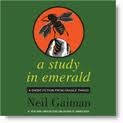I was thrilled to see a title by Neil Gaiman on my English Literature syllabus. I have a mad crush on the British fantasy and graphic novel author dating way back to the early 1990's when singer/songwriter Tori Amos started talking about him in several of her songs. Gaiman is an utterly fabulous writer. If you've never listened to him narrate one of his works on audiobook, you are missing out ladies--his voice is magic! As a writer of juvenile and young adult stories, I find myself more drawn to his titles for children: The Graveyard Book and Coraline are my favorites. However, I have also greatly enjoyed Gaiman's Neverwhere, Stardust, American Gods and now A Study in Emerald.
(Neil Gaiman)
From the opening paragraphs of A Study in Emerald (2003) the reader is able to draw very direct similarities between one of the main characters "London's only consulting detective" and another, well-known, character from English literature, Sherlock Holmes. The story is, in fact, a Sherlock Holmes pastiche. A pasti-what, you say? Well, that was precisely my reaction, too, as I was previously unfamiliar with the pastiche [pa-steesh]. Dictionary.com defines the term as 1. a literary, musical, or artistic piece consisting wholly or chiefly of motifs or techniques borrowed from one or more sources. 2. an incongruous combination of materials, forms, motifs, etc., taken from different sources; hodgepodge. A Study in Emerald is an award-winning short story written in the style of a classic Holmes pastiche and roughly follows the plot of the first Homes novel A Study in Scarlet while mixing in a little of the Cthulhu Mythos universe of horror writer H. P. Lovecraft. (http://tvtropes.org/pmwiki/pmwiki.php/Main/AStudyInEmerald)
"As a Holmes pastiche, A Study in Emerald borrows strongly, liberally and enjoyably from the Holmes mythos to produce a tale that is a ridiculous amount of fun," says Ian Holloway of The Steam Punk Review. While none of the characters are explicitly identified in the text, it is strongly hinted that the detective and his veteran friend are Professor James Moriarty and Colonel Sebastian Moran (who, in Doyle's original stories, are the criminal mastermind arch nemesis of Holmes and his right-hand man/accomplice). (http://enwikipedia.org/wiki/A_Study_in_Emerald) Some similarities include:
- The detective character has written a paper on "The Dynamics of an Asteroid". In Sir Arthur Conan Doyle's original, Moriarty is the author of this paper. (Doyle, The Valley of Fear)
- The narrator signs his name a the end of his story, which takes the form of a Victorian periodical or newspaper in its online version, with the initials 'SM', indicating that he is Sebastian Moran.
- The 'detective' character is described to have a 'thin smile', a physical characteristic Doyle repeatedly used to describe villains in his stories.
- The narrator mentions on several occasions what a crack-shot he was before being injured. In the original story, Moran is described as an expert marksman. (Doyle, The Return of Sherlock Holmes)
- In Gaiman's story, 'Sherlock' is a gifted actor. In Doyle's A Scandal in Bohemia, Sherlock is said to be a master of disguise and Watson laments "The stage lost a fine actor, even as science lost an acute reasoner, when he became a specialist in crime."
What makes the story brilliantly Neil Gaiman, however, is his infusion of another genre, namely H. P. Lovecraft's Cthulhu Mythos universe of horror. Cthulhu mythos is another odd term I was unfamiliar with. It was coined by writer August Derleth to describe the works of H. P. Lovecraft and writers influenced by him including Neil Gaiman. (http://www.yog-sothoth.com) The world in which Gaiman's A Study in Emerald takes place is one that has seen war between humanity and the Great Old Ones (an alien race and Lovecraft example), who now rule Earth. The detective's investigation surrounds the death of a member of the Bohemian royal family and leads him to a "restorationist", an anarchist who believes that the "Old Ones are not the benevolent rulers they are portrayed as, but vicious, soul-destroying monsters feeding on madness and death, and that humanity should be master of his own affairs." (wikipedia)
At its core, A Study in Emerald is the continuation of a "great game", one that has been going on for decades, in which various authors come up with creative and absurd ways of placing Sir Arthur Conan Doyle's beloved Holmes and Watson in "new" adventures. (Britt, Ryan) By introducing some of H. P. Lovecraft's classic trophes, perhaps Neil Gaiman does this amongst the best of them.
References:
A Study In Emerald-Television, Tropes & Idioms. http://tvtropes.org/pmwiki/pmwiki.php/Main/AStudyInEmerald. web.
Holloway, Ian. A Study in Emerald. The Steampunk Review. August 2008. http://thesteampunkreview.blogspot.com/2011-08-study-in-emerald-html. web.
Doyle, Arthur Conan. The Valley of Fear.
Doyle, Arthur Conan. The Return of Sherlock Holmes.
Doyle, Arthur Conan. A Scandal in Bohemia.
Britt, Ryan. The Great Pastiche Game: Notable Non-Doyle Holmes Books. http://www.tor.com/blogs/2011/12/the-great-pastiche-game-notable-non-doyle-holmes-books-html. web.



Very well done, Betty. Gaiman is my favorite contemporary author and I really enjoyed your post.
ReplyDelete